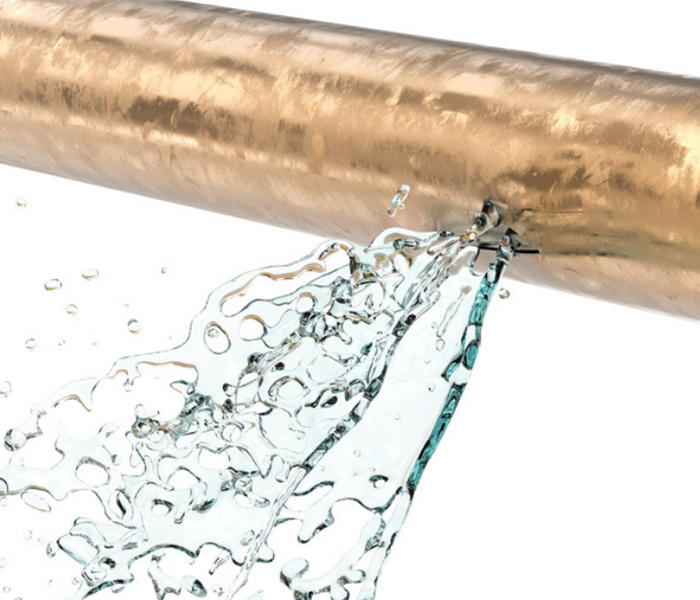Recent Water Damage Posts
How Leaky Faucets and Mold Growth Go Hand-In-Hand
1/24/2023 (Permalink)
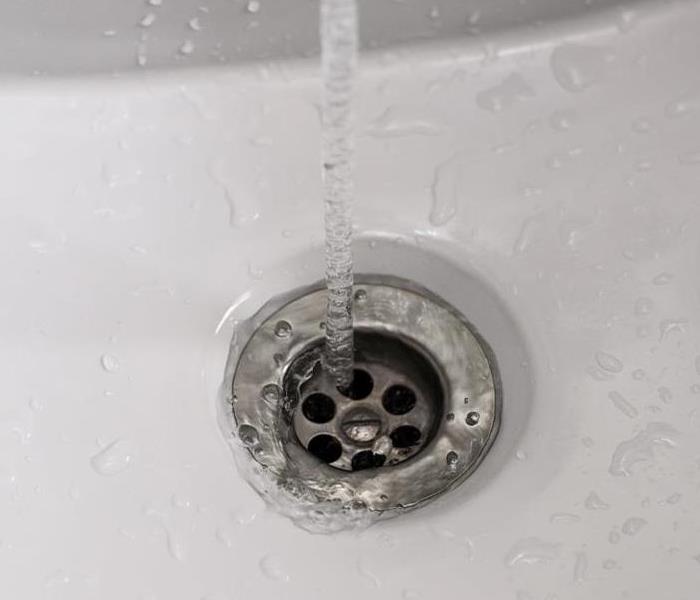 A leaking faucet can be a small inconvenience or a big problem, depending on where the leak occurs.
A leaking faucet can be a small inconvenience or a big problem, depending on where the leak occurs.
If you have a leaking faucet, it is important to get it fixed as soon as possible. Fixing a leaking faucet could be a simple fix or could require extensive repairs. In this article, we will discuss tips and tricks for dealing with a leaky faucet.
Timing is Everything
A leaky faucet can be a small inconvenience or a big problem, depending on where the leak occurs. A slow drip from your bathroom sink may seem like no big deal, but if it's been going on for months and you haven't done anything about it, you could have an expensive problem on your hands.
When leaks are left alone for long periods of time, mold has been known to grow in the area around the source of the leak. The longer a leak goes unrepaired, the worse the mold buildup will become — and since mold tends to go undetected until its effects become visible (such as when it discolors walls or causes ceilings to cave in), its presence can lead to further damage throughout your home.
If you find yourself with a leaky faucet, it's important to clean up the water within 24-48 hours of its onset. This is the ideal time frame for mold growth prevention. If you're not able to clean it up in this window, call a professional. The longer the water sits and drips, the more mold will grow in your home and on surfaces such as floors and walls.
Fixing the Problem
What should you do if your faucet starts leaking? First of all, turn off the water supply while working on fixing it so that there is no extra water coming out of it while working on it. If there's not enough space under your sink for you to work comfortably, then move things around so that there is more room for yourself underneath the sink.
Small Leak Can Cause Major Problems
While it's true that a small leak from a faucet can cause major problems if left unchecked for too long, it does not necessarily mean that you will develop mold in your home. Mold can grow anywhere there is a water source, but mold still needs time to grow.
Mold spores are microscopic and float throughout our environment. The spores need something damp to feed on in order to grow into colonies of mold. If this dampness is present in your home, then you may have an issue with mold development on your property.
A leaking faucet can be a small inconvenience or a big problem, depending on where the leak occurs. If you have a leaking faucet, it is important to get it fixed as soon as possible. When you have a leaky faucet that leads to a mold problem, SERVPRO of West Hamilton/Oxford is here to help you get your Oxford home back to normal as quickly as possible. Give us a call at the first sign of mold.
How To Clean Up Water Damage After a Water Leak
12/5/2022 (Permalink)
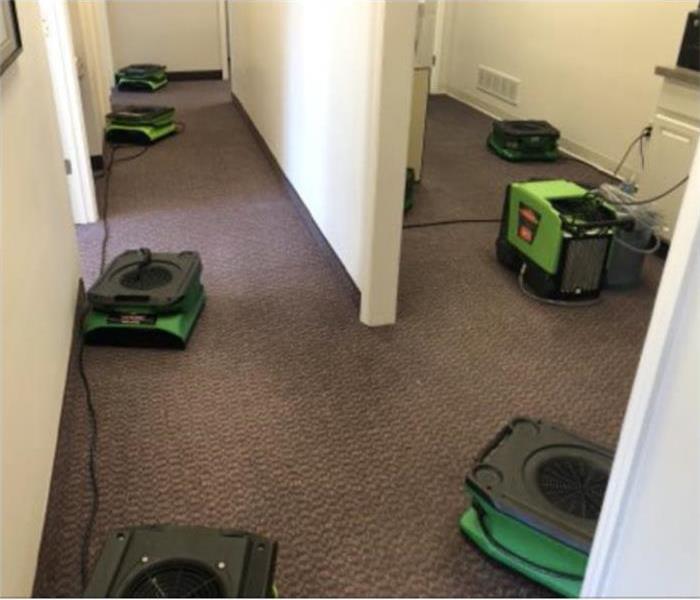 Water damage in Hamilton, OH.
Water damage in Hamilton, OH.
Tips for Cleaning Up a Water Leak
Water damage is one of the most common reasons for a home insurance claim, and it can happen in a variety of ways. You might experience a burst pipe, see signs of water damage after a storm, or even notice water seeping from your walls. Regardless of what caused the leak or how much water got into your home in Hamilton, OH, SERVPRO of West Hamilton/Oxford is here to help! We offer mold remediation services along with our water mitigation services so you can get back on your feet quickly.
Shut off the water
Shut off the main water valve. This is typically located in your basement or garage, and it will look like a big red knob on a pipe with a blue handle. If you don't know where this is, call a professional to help you turn the water off right away.
If that's not an option, call a professional anyway! You can wait until another day to find out where it is or how to turn it off—but by then there might already be damage done!
Contact your insurance company
If you have an insurance policy, you should contact your agent or company immediately to file a claim. The sooner you call them after a leak has occurred, the less time there will be for mold to grow.
Mold can easily spread throughout your home if left alone for even short periods of time—but it can also be removed with some effort and patience. To prevent mold from growing back in its place, it is important to have a trained restoration professional on-site as quickly as possible to take care of the mold remediation.
Make sure the area is safe.
Once you have the wet area secured, it's time to move on to the next step: making sure everything is safe. Make sure that all appliances and heating vents are turned off and do not turn them back on until they've been inspected by a professional who can be sure they are safe. Also check your electrical system for any signs of damage or fire hazards before touching anything else.
Call SERVPRO of West Hamilton/Oxford immediately
When you have water damage in your home or business, it's important to act fast and call SERVPRO of West Hamilton/Oxford immediately. We can help with everything from the initial response that prevents further damage to professional drying, cleaning and restoration services. The faster we get into the affected area, the better our chances are of saving your home and personal possessions from water damage.
The sooner we begin working on your project, the more likely it is that we'll be able to minimize structural issues as well as prevent mold growth. If you wait too long after a leak occurs before calling us for help, then we may not be able to perform services like removing drywall or carpeting because these materials would have already been damaged by mold growth. Call us first so that one of our trained technicians can start treating your property right away!
Water damage is something that no homeowner wants to deal with. And when it happens, it’s important to act quickly. If you do find yourself with water damage after a leak or flood in your home, contact SERVPRO of West Hamilton/Oxford immediately so we can help you get back on track as soon as possible.
Preventing Your Pipes From Freezing
11/21/2022 (Permalink)
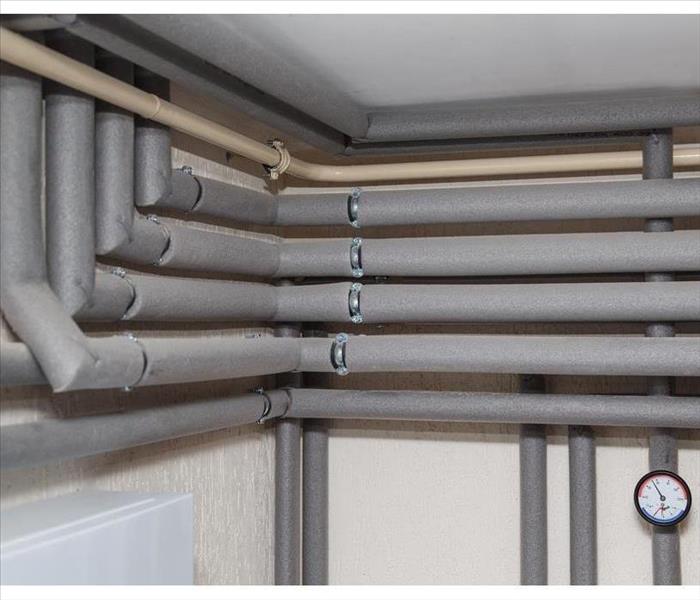 Insulate any exposed pipes that are vulnerable to freezing
Insulate any exposed pipes that are vulnerable to freezing
Keep Your Pipes From Freezing
If you live in a colder climate, the danger of frozen pipes is real. If your home's water supply freezes, it can cause serious damage to home appliances and fixtures. The good news is that there are steps you can take before and after the coldest days of winter strike to prevent frozen pipes from occurring in your home.
When Temperatures Drop Below Freezing, Beware of Freezing Pipes.
When temperatures drop below freezing, it is time to worry about water pipes in your home freezing. Frozen pipes can burst and cause flooding, they can cause damage to your Hamilton, OH home's foundation or structure, and they can also cause water to leak into your home. If the water is not contained within a frozen pipe, it will start seeping through cracks in the wall or flooring. This can lead to mold and mildew growth.
There are several ways that you can prevent freezing pipes:
- Insulate your water supply lines with foam insulation tape if possible
- If you cannot access these lines directly then use an insulation blanket around them instead
- Be sure any windows that do not have storm shutters on them are covered properly with clear plastic sheets so cold air does not enter through them
- Keep all vents closed off from areas that could be exposed due to drafts causing cold air currents
How to Avoid Pipe Freezing
Use heat tape. If you have an electric water heater, consider running a small space heater near it. You can also use heat tape to insulate valves and pipes in your basement or crawlspace, but keep in mind that it's a fire hazard if used improperly.
Use insulation. Insulate any exposed pipes that are vulnerable to freezing by wrapping them with foam or cloth pipe sleeves or other types of insulation. Before wrapping them up though make sure there are no leaks first!
Check for leaks and turn off the water supply when you leave your house, so you don't come back to frozen pipes.
How To Thaw Frozen Pipes
There are several ways to thaw frozen pipes. The best way to thaw them is by using hot water, but not just any old hot water -- you need to ensure that the temperature is high enough so that it will be able to melt the ice without damaging your pipes.
If you want to use hot water, here are some options:
Use a hair dryer set on "high" and directed at the pipe. This will take longer than other methods but won't damage your plumbing.
If there's an outlet nearby where you can plug in a space heater or blow dryer, turn those appliances on low and point them at the affected area for ten minutes or so until everything melts away. You can also try putting towels soaked in very hot water against frozen pipes; they'll help transfer heat into them faster than if they were left alone in the cold air around them!
Alternatives to Permanent Pipe Freezing Protection
While protecting your pipes from freezing is important, there are other options that can help you save money on heating costs.
Insulate the spaces around your pipes. If you have an attic or basement, it's a good idea to insulate any areas where cold air or water might be able to get inside and freeze the pipes. You can also insulate crawl spaces or basements if they're exposed to outside temperatures all year round. This will help keep the temperature inside these areas warmer than outside, preventing freezing in those places as well.
Replace outdoor faucets with frost-proof models or reroute pipe runs so that they don't run through unheated areas such as garages or porches during winter months of low humidity (this is what I did for my outdoor spigot).
Place space heaters near pipes that may be prone to freezing during cold weather periods when regular heating systems aren't working properly.
The best way to prevent pipe freezing is to keep your home warm by using space heaters or blankets. If you cannot afford these options, then you can use a blow dryer on low and place it near the pipe that has frozen. Another option would be to wrap the frozen pipe in towels soaked in hot water as soon as possible; this should thaw out any pipes that have been damaged due to cold temperatures outside your home.
5 Tips to Prevent Spring Flooding at Your Business
8/30/2022 (Permalink)
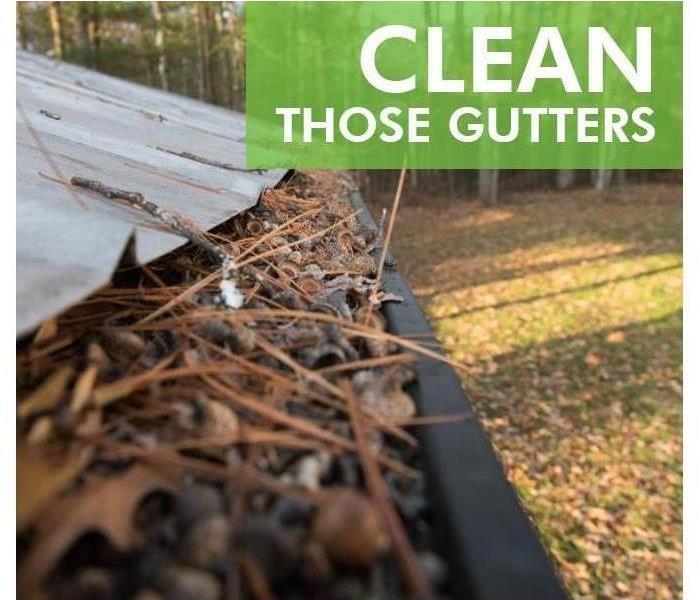 Gutters can collect a large amount of debris.
Gutters can collect a large amount of debris.
Prevent Spring Flooding at Your Business
After a long winter, it is finally time to start planning for the warmer months ahead. If you own a business in Ross, OH, spring can be a busy season for profits, but it also is a busy season for flooding. Fortunately, there are things you can do to prevent problems during the next thaw. Follow these steps to reduce the chances of needing to hire a water damage restoration professional once the weather warms up.
1. Relocate Snow
Never underestimate the water capacity in a pile of snow. For this reason, you will want to clear any away from the building's foundation. Ideally, snow should be at least three to five feet away, but the further away it is, the better.
2. Clean Out Gutters
After dealing with the snow, you will need to lookup. Over a long winter, gutters can collect a large amount of debris. Leaves, sticks, and dirt can lead to blockages which can force water to seep into the building.
3. Make Repairs
Next, look around the property. Few things lead to flooding like a frozen pipe. Check plumbing carefully. Seal leaks and insulate exposed pipes. While making repairs, do not forget the foundation. If you see cracks, do not ignore them.
4. Optimize Landscape Drainage
How does water drain around the building? If necessary, regrade the surrounding land to allow for better drainage. You may need to move plants and soil to do this, but it can be worth it.
5. Consider a Professional Inspection
If you are still feeling unsure about how your building will hold up to this spring's thaw, scheduling an expert inspection can give you a peace of mind. Sometimes, it is just better to know.
When the weather finally warms up, your business should experience spring profits, not a spring flood. By following these steps, you can reduce the chances of encountering common flooding problems.
Tips for Pipe Protection
3/24/2022 (Permalink)
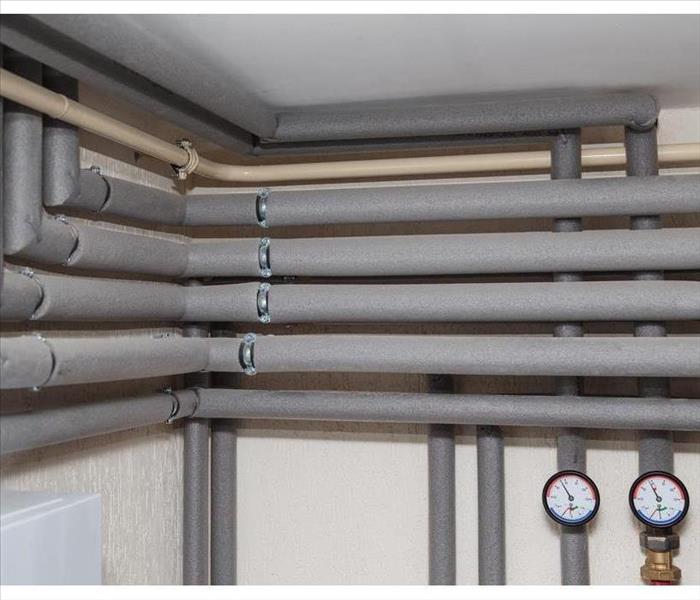 Add insulation to your pipes.
Add insulation to your pipes.
Avoid Bursted Pipes In Your Home
Frozen pipes are often the culprit when homes flood in the winter. Fortunately, prevention of this problem is pretty easy. To keep your home in Reilly, OH, safe from flooding due to busted pipes, try the following methods.
1. Insulate Pipes
The most long-term solution for avoiding pipe freeze and thus the need for water restoration services is adding insulation. You can either add it to the pipes themselves by sliding a fiberglass sleeve over them or you can add extra insulation to the walls. The latter option may even save you money on heating bills!
2. Heat Air
Always keep the heater in your home on if there is a chance that outside temperatures will dip below freezing. Then, you can warm up the air around the pipes by venting the heat from your home into the walls. For pipes that are under your sink, you can keep the cabinet doors open so that the area under the sink heats along with the rest of the house.
3. Open Faucets
Allowing a slow drip from select faucets throughout your home is an easy way to prevent frozen pipes. Moving water is less likely to freeze than standing water, so the constant flow through the pipes works in your favor.
4. Seal Cracks
Another way to increase your home's energy efficiency while also protecting your plumbing is to maintain proper seals in walls, floors, ceilings and windows. Gaps allow wind to get in from outside. By caulking those gaps, you can keep warm air in and cold air out.
5. Apply Heat
Sometimes, the direct approach is helpful. You can use heating tape directly on pipes to heat them up. Whether you choose tape that switches on when it sense the need to do so or tape you can turn on and off manually, pipes that are most vulnerable to freezing are protected.
You can avoid frozen pipes and the mess they can make with these simple methods. Following these five tips can keep your plumbing warm all winter.
3 Proactive Ways To Prevent Plumbing Problems
3/16/2022 (Permalink)
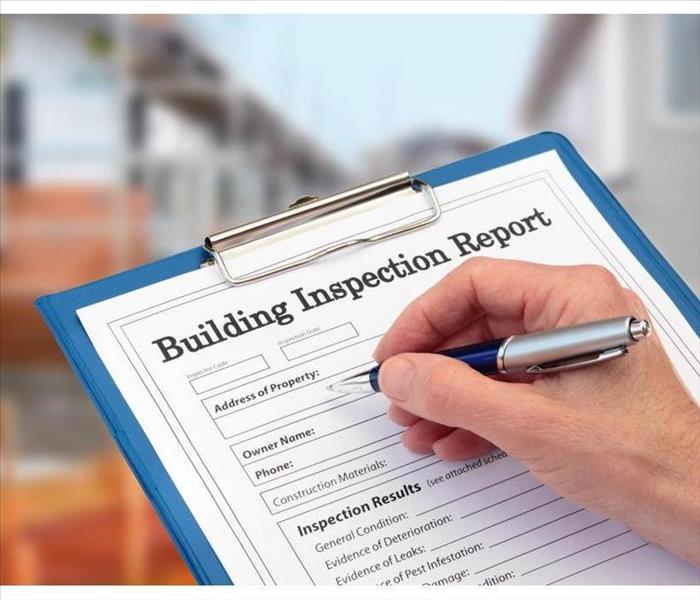 Annual plumbing inspections are sufficient for many commercial buildings.
Annual plumbing inspections are sufficient for many commercial buildings.
Prevent Plumbing Problems
There are several measures a commercial property owner can take to maintain water systems and keep plumbing problems such as pipe breaks and leaks at bay. Proactive maintenance is much more affordable than arranging for emergency repairs at a building in Lemon Township, OH. Here are three ways to keep costs down and ensure a structure has a reliable supply of water and functional drainage.
1. Schedule Annual Inspections
A business or building owner should have a commercial property inspected at least once every 12 months. These checks should include checking the condition of supply lines, the water main and making sure that sewer lines are not becoming clogged. It can also be helpful to confirm the quality of pipe installation and adherence to the most current plumbing codes.
2. Monitor Pipe Condition
During a plumbing inspection, the owner of a commercial property should consult with a plumber about the condition of pipes, including levels of corrosion to avoid a broken pipe or other plumbing problems. If pipes are making loud noises such as knocking, it may be possible to add insulation or support to prevent damage. Property owners should be aware of the material and age of pipes in a building.
3. Maintain Drain Lines
A commercial property owner should post guidelines in bathrooms specifying that only toilet paper is safe to flush. Buildings with commercial kitchens should take measures to reduce the amount of grease that goes down the drain. It may be necessary to have drain lines cleaned by professionals every 18 to 22 months to prevent sewer damage.
Inspections and awareness of the age and condition of pipes such as supply and sewer lines can prevent most plumbing problems. Annual plumbing inspections are sufficient for many commercial buildings in Lemon Township, OH. Restaurants and other businesses with unique drainage demands may need to schedule more frequent plumbing service.
How To Keep a Frozen Pipe From Breaking
1/22/2022 (Permalink)
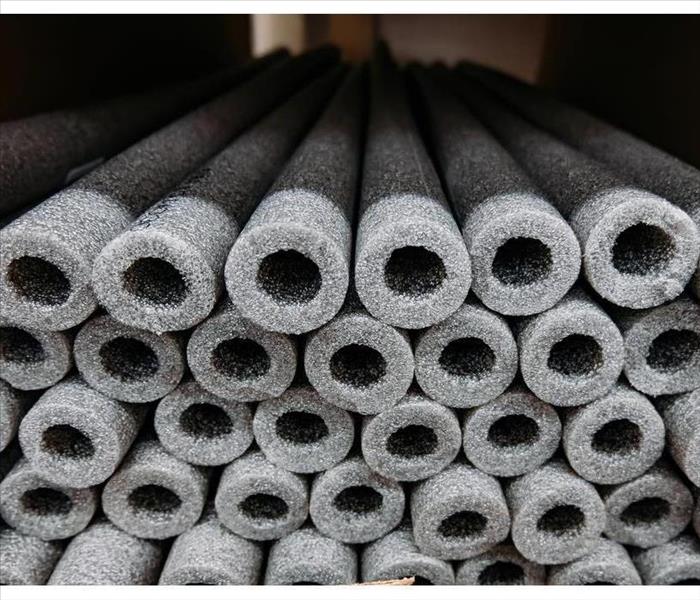 More long-term solutions include pipe insulation.
More long-term solutions include pipe insulation.
Steps To Prevent a Flood
Water damage can be expensive to repair and can lead to secondary damage if it’s not fixed promptly. Frozen pipes are one of the leading causes of water damage in homes in Millville, OH, but if you identify and unfreeze the pipe before it ruptures, you can often save yourself the hassle of having to fix the pipe and clean up its aftermath. Follow these steps to prevent a flood.
1. Finding the Pipe
You may find that one faucet is working and another is not. This could be a sign of a pipe freeze between the two fixtures. You are more likely to find a frozen pipe near certain areas:
- Crawlspaces
- Attics
- Basements
- Outdoors
- Air vents
2. Inspecting the Pipe
To make sure you don’t already have a leak, you need to inspect your frozen pipes closely. Make sure that the surface doesn’t show any signs of cracks. If you find a crack, it is important to patch it before warming the pipe up. Turn off the water main to minimize leaking while the pipe is repaired.
3. Running the Faucets
If you don’t see any cracks, you can turn on the faucets. This gets water running and helps the faucet warm up gradually, as moving water does not freeze as readily as still water.
4. Warming the Pipes
There are several ways to warm up a pipe that holds frozen water. You can use a hair dryer for immediate warmth. More long-term solutions include heat tape and pipe insulation. If you can redirect warm air from your heater during the winter or from outside during warmer months inside your walls, this can keep pipes from freezing by warming the space around them.
If your frozen pipes do cause water damage, water restoration specialists are here to help. The best solution, however, is to prevent flooding in the first place by keeping pipes warm.
How Many Days Does Water Damage Cleanup Take?
12/22/2021 (Permalink)
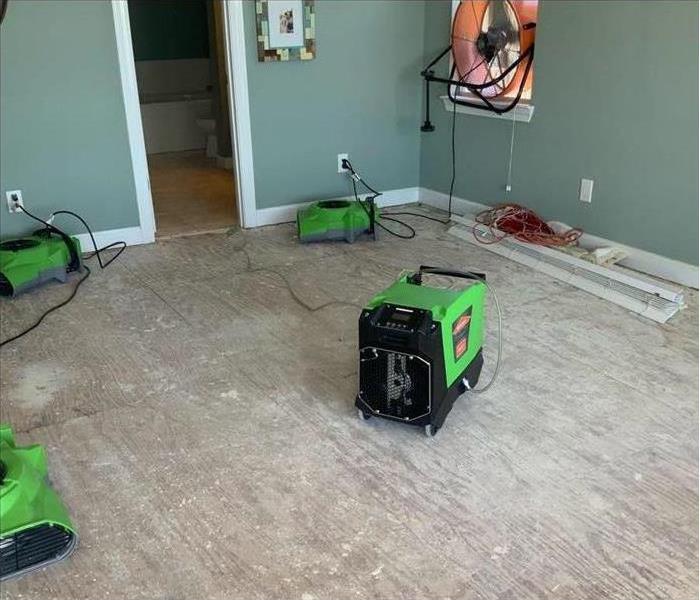 Drying Equipment is crucial in the water damage restoration process.
Drying Equipment is crucial in the water damage restoration process.
Water Damage Cleanup
If unexpected bursting pipes in your home created a flood recently, you may be wondering how long it will take to clean up the water damage. It is easy to understand why a proud homeowner wants to know if and when things will be back to normal. Keep reading for the answers you are looking for.
Typical Cleanup Timeframe
A good Hanover Township, OH, water damage restoration company should be able to take care of the cleanup process in about three to five days. Many technicians are able to come to your home on an emergency basis to quickly survey the situation and develop a thorough remediation plan for your bursting pipes disaster. Although the steps may vary according to circumstances, they often include these interventions.
- Remove soaked carpeting, curling floor tiles or ruined wood floors.
- Drill holes and use instruments to check moisture in the subflooring and drywall.
- Use commercial fans and dehumidifiers to remove dampness.
In some cases, these professionals will be able to restore valued photographs, important papers and other hard-to-salvage items. Keep in mind that you should also find a way to fix the broken pipe or pipes during this time to prevent further damage. If you are not able to repair the problem yourself, contact a qualified professional to take care of the matter to protect your home and belongings to the best of your ability.
Exceptions in Special Circumstances
Sometimes, your home will require more thorough cleanup that could take extra time beyond what is normally required by a restoration team. For example, a soaked wood floor may require between seven and ten days for proper renewal. Talking to the on-site team about their cleanup plan and expected timeframes are your best bet if you want to know what the process will involve.
Bursting pipes and moisture destruction can be tough for anyone to face, but having the help of knowledgeable professionals can make a difference in most situations. A damage remediation team that knows the unique challenges of emergency flood circumstances can help the restoration process go as smoothly as possible for you, your family and your Hanover Township, OH, home.
Why Basements Flood
11/22/2021 (Permalink)
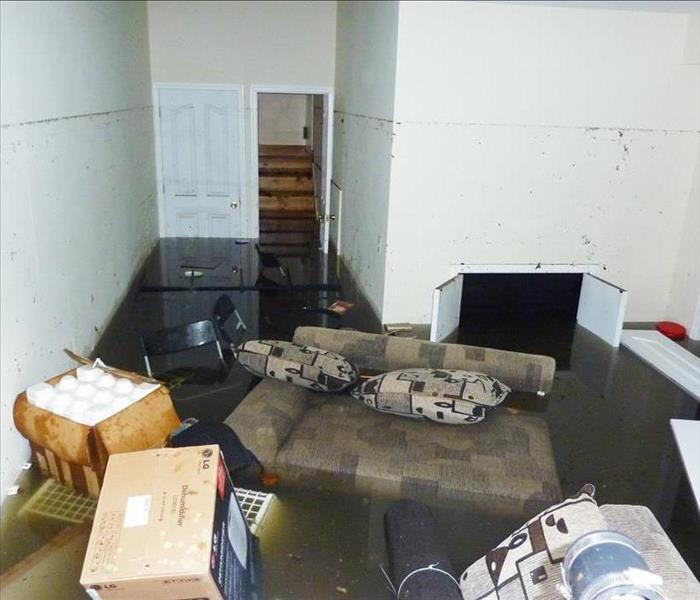 If your basement is flooded contact a professional as soon as possible.
If your basement is flooded contact a professional as soon as possible.
Storms and flooding in Hamilton, OH, can lead to water buildup in the basement. As a homeowner, it’s important to understand what to do in these situations, how water gets down there in the first place, and ways to help prevent lasting damage.
How Water Gets Into the Basement
The first reaction for many when looking at a basement flood is to wonder how the water got there in the first place. There are several factors that may come into play.
- An improperly functioning sump pump
- Poor drainage around basement walls
- Cracks or holes in the walls water can leak through
- Issues with basement plumbing, such as a water heater
- Heavy storm rains
Water buildup in the basement can cause further problems for your home. As water tends to flow in the least resistant path, it will find holes and cracks to flow through and continue to puddle at the lowest point unless otherwise prevented.
How To Take Care of Water in the Basement
If you find flooding in your basement, it’s best to contact a professional as soon as possible. He can assist with pipe repair, if needed, take care of the water removal, and assess your basement for the source of the problem. Many services also offer help with the drying and sanitation of the affected areas, as well as repair and mold remediation.
How To Prevent Floods
In some cases, there may be ways you can help prevent damage from a basement flood. These can include installing a sump pump if you do not currently have one, regularly checking to make sure plumbing is intact, and sloping your yard and landscaping away from your home. A professional may have further ideas on ways to help prevent water damage.
Understanding the how and why of basement flooding can help you contact the team you need for repairs and restoration. Knowing these things can also help you take the steps necessary to help protect your home.
Business Interruption Insurance: Understanding Your Coverage and Your Needs
9/27/2021 (Permalink)
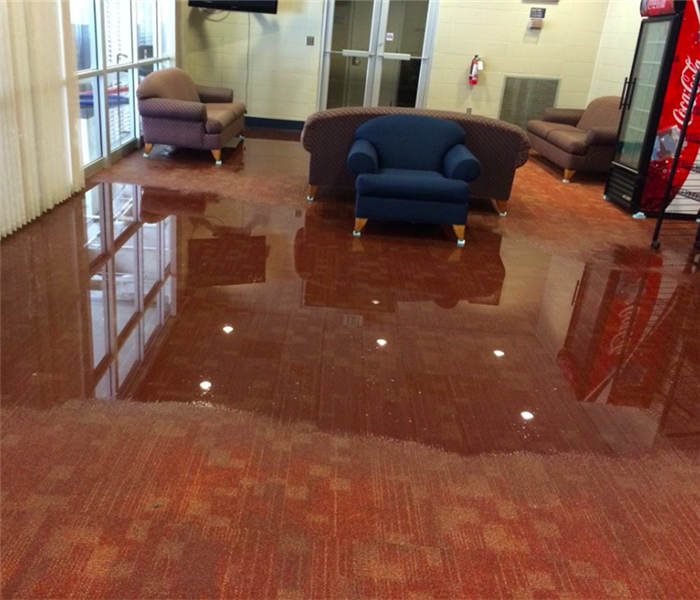 The cost associated with business interruption insurance should not worry you as a business owner.
The cost associated with business interruption insurance should not worry you as a business owner.
As a business owner, you have many day-to-day concerns, but most likely a broken pipe and flooding are lower on that list; however, large water damage can shut your operation down for possibly weeks. This type of disaster, the temporary loss of business, may be covered under your current policy under the heading of business interruption. If you’ve never heard of this coverage, and there’s no shame in that, you want to read through the questions below to learn the basics.
1. What Is Business Interruption Insurance?
Business interruption insurance is just what it sounds like, a policy to protect your business in case of any significant interruptions due to unforeseen damage or disaster. Primarily, these policies aim to minimize your loss when your business is forced to shut down due to restoration efforts. These policies can float your business by instituting what they call policy limits.
2. What Are Policy Limits?
Policy limits refer to the amount of money that your insurance policy will provide the business after experiencing a shutdown due to a disaster, like flooding. It is important to ensure that the policy limits offered will be enough to cover your typical operation needs; however, policy limits can vary based on location and type of business.
3. Why Do Costs and Policy Limits Relate to Business and Location?
Most of the business interruption insurance plans, while typically a part of your overall coverage, can vary in price and policy limits depending on the type of business and the location. This variance is due to the overall risk to the insurance company. For instance, living in Hamilton, OH, the risk of weather damage is high, and if you couple that with a restaurant, with an increased chance of fire, then insurance coverage will likely be more expensive with lower policy limits because of the increased likelihood of a payout.
The cost associated with business interruption insurance should not worry you as a business owner, as they are likely already figured into any commercial coverage. What should concern you is operating a business unprotected with low policy limits, leaving yourself and your property vulnerable to disasters, like flooding.
How To Make Your Meeting With the Adjuster Go Smoothly
7/12/2021 (Permalink)
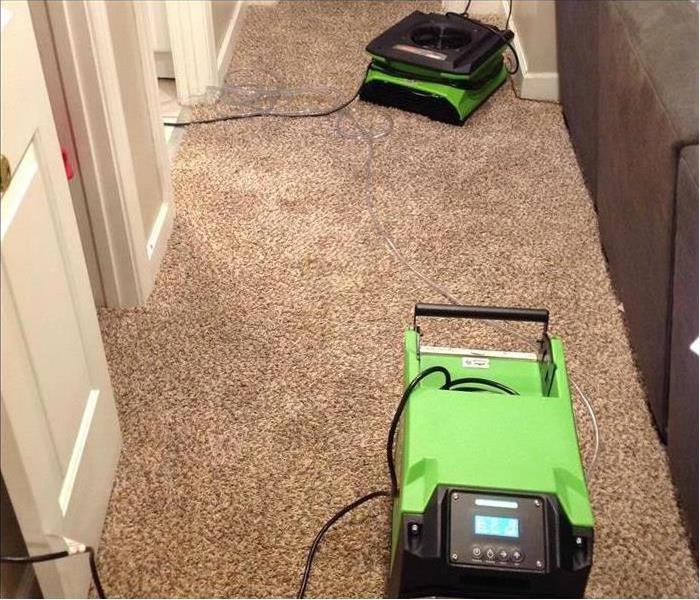 Drying carpet in a home that suffered from water damage.
Drying carpet in a home that suffered from water damage.
Making a claim after a flood in your Trenton, OH, home can leave you feeling overwhelmed. Your provider may want you to take pictures of the damage, meet with a home adjuster and hire a professional cleanup team.
Use this quick guide to help prepare for your meeting with the adjuster.
- Make a list. Chances are the adjuster is going to want to go over the details of your loss. You should make a list of any belongings damaged in the flood. Try to remember when you purchased each item and how much it might cost to repair or replace it. You should also include structural damages in your list. If possible, include pictures to give the adjuster a visual idea of what happened to your home.
- Keep the damaged items. Even though you made a list and took pictures, you should still keep any furnishings, building materials or belongings you plan on throwing out. The home adjuster may want to see the destroyed items to better understand the extent of the flood.
- Get a quote. If you already know who you want to tackle your restoration, you should get a quote. The adjuster may set a specific budget for your insurance claim.
- Keep receipts. Sometimes it may take a while for an adjuster to make it out to your home. If you have to start the repairs before your home is inspected, you should be sure to keep all receipts of the work done. Remember to also keep before and after pictures of your house to help the insurance investigator better understand what happened.
A home adjuster is sent out by your insurance provider to figure out the extent of your loss after a flood. Because this person may decide how much money you get from your policy to do the repairs, you want to make sure the meeting goes well.
How You Can Prepare for a Home Adjuster's Visit
3/16/2021 (Permalink)
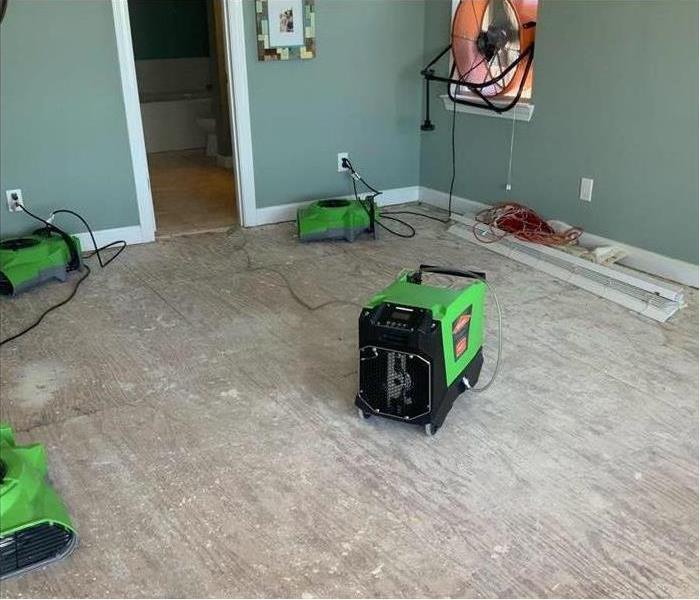 Contact a water damage remediation service to begin drying your home.
Contact a water damage remediation service to begin drying your home.
How To Prepare Ahead Of Time
If you've just sustained water damage to your property, make sure to call your insurance company right away so you can begin the claims process as soon as possible. Soon after the initial call, they'll send out a home adjuster to assess the damage and file a report. Though he or she will be the one to make the official report, there are things you can do that will help move the process along faster. Here's how you can prepare ahead of time to make that happen.
Document the Damage
You know your home better than anyone, so you are not likely to miss anything that's been damaged, no matter how small. Take a detailed inventory of what's been damaged and lost — in writing, in photos and on video, if possible. You can ask the adjuster to include them in the report alongside his or her findings.
Clear a Path
Clear the way for the home adjuster to move freely around your property, so nothing will be missed. If you have to move the debris to do that, make sure you don't remove it entirely. The insurance claim needs as much evidence as possible included so that you receive the proper coverage and reimbursement.
Prevent Further Damage
Contact a water damage remediation service in Lemon Township, OH, to begin drying everything out and keep further damage at bay. The team will also help you itemize and categorize the damages and losses you incurred.
Know Your Policy
Before the adjuster arrives, review your policy with your agent. You should know what is and isn't covered, the limits of your policy and when to expect reimbursement so you can start making arrangements for repairs and replacements.
When the worst happens and your home sustains serious water damage, it's nice to know you have qualified professionals in your corner. Your insurance company and the home adjuster will work with you to make sure you get the help you need and get back on your feet as soon as possible.
What You Should Know About Category 3 Water Damage
1/4/2021 (Permalink)
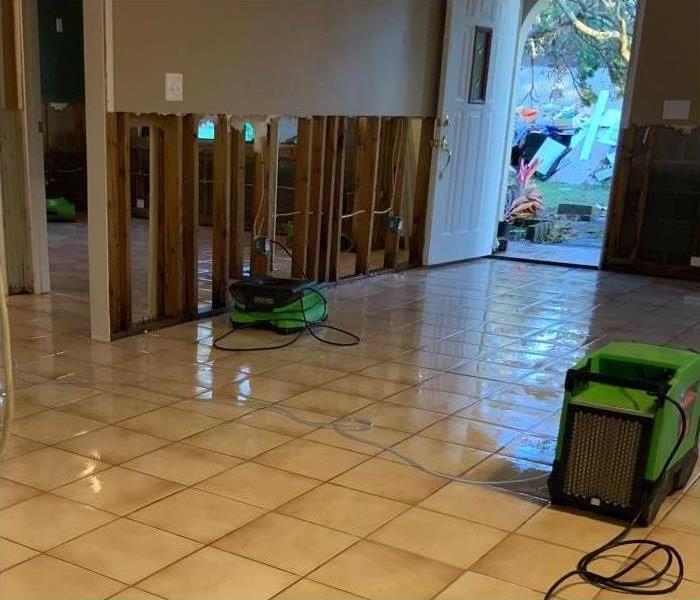 Water damage in an Oxford, OH home
Water damage in an Oxford, OH home
When water damage occurs to your home in Oxford, OH, it is vital to prevent additional issues as quickly as possible. You want to get everything cleaned up right away. However, when Category 3 black water is present, it is not safe to do this yourself.
What Are the Water Damage Categories?
Different water carries varying levels of health risks. The bacteria present depends on the source. Some potential causes of flooding in your home include:
- Weather events
- Clogged gutters
- Broken pipes
- Sewage backup
- Appliance malfunctions
There are three types of restoration categories based on the cleanliness of the floodwater:
Category 1 damage is from clean water resulting from broken pipes, overflowing sinks or bathtubs, and rainwater leaks. This water does not pose a health threat to people and can be cleaned by removing any standing moisture and drying with an air mover.
Category 2 water contains contamination from chemicals, mold, or bacteria stemming from broken dishwashers, overflowing toilets, sump pump failures, or broken aquariums. Cleanup of this type requires personal protection equipment and carpet padding replacement.
Category 3 is the cleanup process for black water, which contains toxins and organisms that cause illness and disease. This type of flood requires professional restoration experts.
What Are the Dangers of Sewage Cleanup?
When sewer backups or rising floodwaters occur, the water is extremely hazardous. Flooding from these sources can contain feces, chemicals, fertilizers, medications, tetanus, and many other risks. Professionals must clean this type of damage to ensure proper drying and sanitation.
What Should You Do to Protect Your Home and Health?
You must call a professional restoration service to address this type of hazardous flooding. The unsanitary water can seep into the structure of your home and cause significant health problems for you and your family. Experts will thoroughly disinfect and restore your home.
Damage from Category 3 black water is an emergency that you must address right away. Enlisting professional help to restore your home to normal is the best way to ensure proper cleanup procedures and precautions.
Why You Need To Protect Pipes During the Winter
11/24/2020 (Permalink)
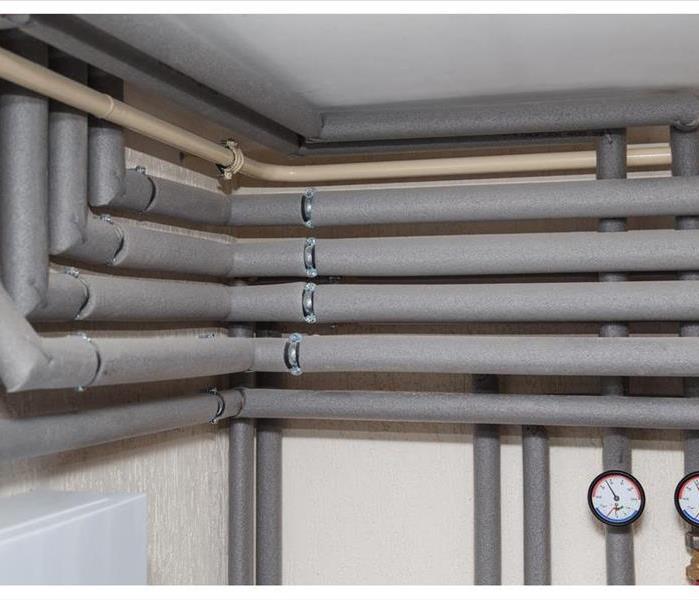 Protect your pipes during the winter
Protect your pipes during the winter
During the winter in Hamilton, OH, it is essential to prepare your home for below-freezing temperatures. Taking pipe freeze prevention measures will keep your home from flooding due to a burst pipe.
What Causes a Pipe To Burst?
Sub-zero temperatures cause the water inside pipes to turn to ice. As ice forms, it expands and creates pressure on the surrounding structure. Eventually, this expansion becomes uncontainable and leads to a burst pipe. Frozen pipes which are susceptible to bursting include ones found in uninsulated spaces, including:
- Kitchen and bathroom cabinets
- Garages and basements
- Attics and crawl spaces
- Exterior walls
A flood cleanup company can help dry out carpets or other furnishings if a burst pipe drenches them.
How To Keep Pipes From Freezing
During the cold months, pipe freeze prevention is achievable by insulating all exposed pipes or maintaining adequate heat circulation around them. These measures can ensure that the water inside does not freeze. Maintaining a consistently warm temperature throughout the day and night, and keeping the heat on while you are away from home will help avoid frozen pipes. Turning on the faucet to allow cold water to drip also ensures that the water traveling through exposed pipes does not freeze.
How To Keep Frozen Pipes From Bursting
If water drips out slowly when you turn on the faucet, this could indicate that your pipe is frozen, and, despite your pipe freeze prevention measures, you need to act quickly. If you determine that a burst pipe has not occurred, cover a portion of the exposed pipe with a heated blanket or use a hand-held hair dryer to warm it gradually. Be careful to avoid extreme heat shock, which could increase the risk of a burst pipe. Keeping the faucet turned on will encourage the existing water flow to dissolve the ice.
If you experience flood damage due to frozen pipes in your Hamilton, OH, home, contact a flood restoration company to handle the cleanup.
Types of Water Contamination
10/12/2020 (Permalink)
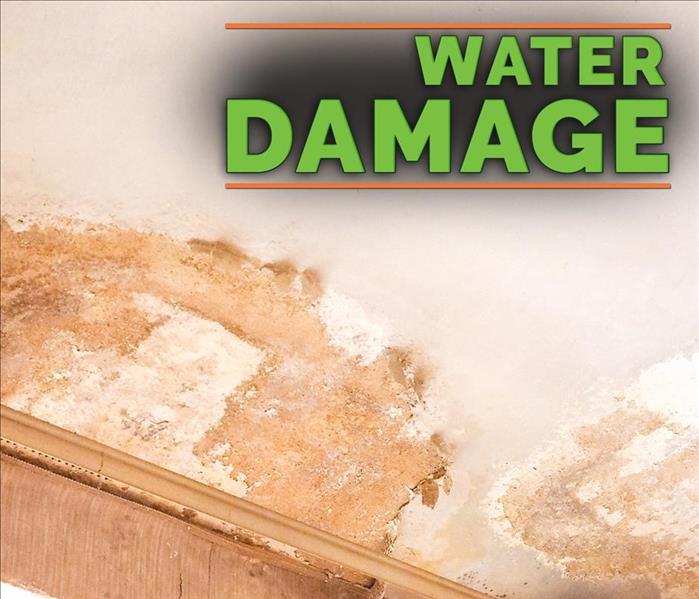 There are three categories of water damage
There are three categories of water damage
Water Damage Categories
Not all floods are the same. There are three different types of floodwater, each categorized by the type of contaminants present in the flood. Among the three categories, black water floods are, by far, the most dangerous. Read on if your residential property in Lemon Township, OH, has recently fallen victim to a flood.
Clean Water Floods
Category 1 floods, also known as clean water floods, are categorized by an absence of contamination. They are typically caused by a supply line burst or overflowing bathtub or shower. They are the least dangerous types of floods, but are still certainly capable of causing massive amounts of water damage if left untreated. In theory, Category 1 flood water is safe for human consumption, but you should still never attempt to drink it.
Gray Water Floods
Category 2 flood water is the next step up from a clean water flood. These floods contain some degree of contamination, although not on a lethal level. They are usually the result of overflowing household appliances, such as dishwashers and washing machines. If left untreated for more than 48 hours, gray water floods can quickly turn into Category 3 floods.
Black Water Floods
Category 3 floods are the most dangerous types of floods. They are categorized by the presence of human/animal fecal matter, raw sewage, dangerous chemical and other types of biohazards. You should never attempt any type of sewage cleanup or flood remediation by yourself when it comes to these types of floods. Instead, you need to contact professional help as soon as you can.
Blackwater floods can cause catastrophic amounts of damage to your residential property if they aren't handled quickly and correctly. Attempting to handle these types of floods by yourself is extremely dangerous due to the biohazards present in the flood itself. Contact flood remediation experts immediately if your home is suffering from any of the floods listed above.
Preventing Water Damage During Construction
8/14/2020 (Permalink)
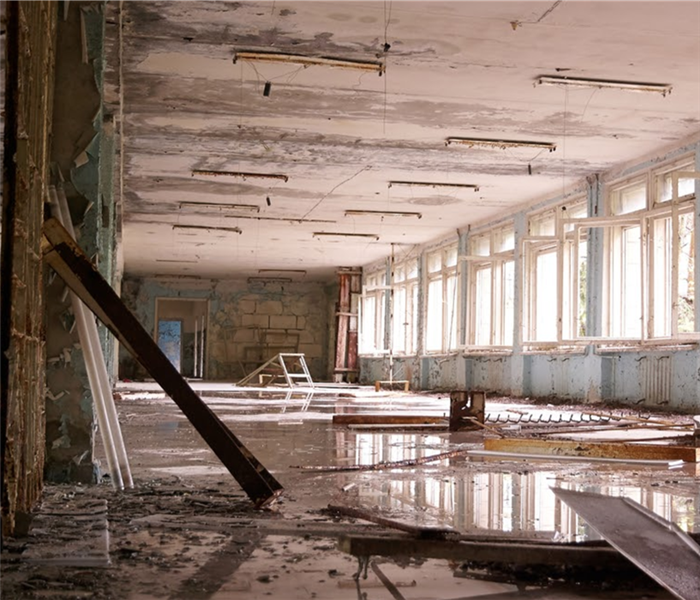 Water damage in a building while in construction
Water damage in a building while in construction
Water damage can be a major problem during a construction project in Trenton, OH. Whether from external or internal sources, water can cause a tremendous amount of physical loss. It can also lengthen the amount of time needed for a project. In the era of accelerated building schedules, a small problem can lead to large losses. For instance, contractors may face water pipe repair fees and the cost of hiring water damage remediation professionals to clean up the flooded area. They may also leave the contractor with an unhappy client and prevent them from getting more jobs. However, prevention can be the key to success.
Have a Plan
Before even starting a construction project, contractors should review the potential for water damage. Then, they should incorporate methods to reduce these risks into their project plan. For example, early in the construction process, groundwater and weather-related events could be dangerous. Preventing loss due to these types of risks will require that the contractor examines the site thoroughly. This will allow them to figure out which dewatering systems are the best for the site. Some potential types of equipment they may use include:
- Special site grading
- Stormwater drains
- Pumps
Once the building is complete and the electric, plumbing, and other systems are being installed, contractors have to worry about a new set of issues. At this point, almost every incidence of water damage has serious consequences. The chances of water damage also become greater. Therefore, this is where contractors will need to have a plan in place to prevent water damage and deal with it when it occurs. For instance, they will likely set aside funds for potential issues that could occur, such as burst plumbing and water pipe repair fees.
Having a plan in place before starting construction can prevent incidences that can lead to water damage, such as a broken pipe. Contactors will also benefit from having preventative measures in place because it plans for issues that could arise from water damage, such as water pipe repair fees.
Clogged Pipe, Snake It Right
5/20/2020 (Permalink)
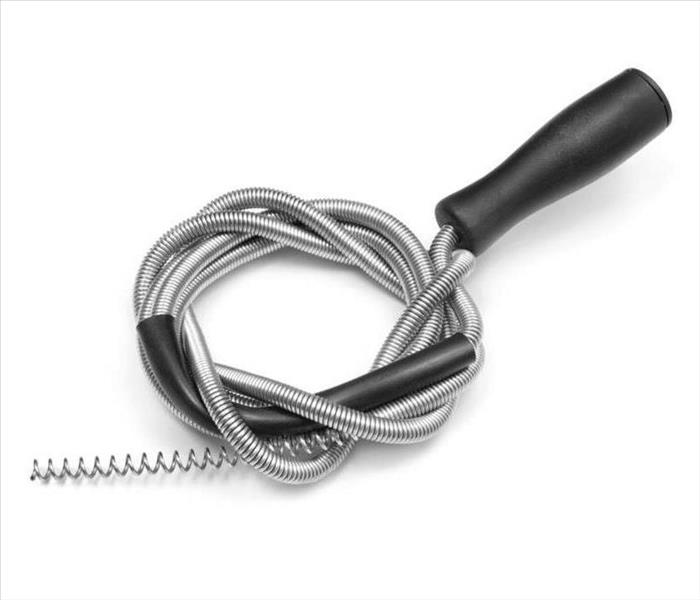 Knowing the best way to use a drain snake can help keep your home flood-free
Knowing the best way to use a drain snake can help keep your home flood-free
How To Snake Your Drains
In an ideal world, your pipes would never need snaking. Unfortunately, no matter how proactive you are about keeping hair and other particles out of the drains of your home in Layhigh, OH, there’s a good chance that, at some point, you’ll have to snake a clogged drain. Here are some tips to help with snaking your drains.
1. Exhaust Other Methods
There are a couple of things you’ll want to attempt before reaching for the snake. Especially if your pipes are draining slowly — as opposed to being entirely stopped — you can try using a plunger or cleaning out the trap. Sometimes the issue is as simple as a buildup of hair around the first couple inches of the drain.
2. Insert the Snake Until You Feel Resistance
Most of the time, the snake will slide easily into your pipes until it hits the clog. As you crank the snake into the pipe, be aware that you might feel some pressure as you meet the turns in the pipes. Once you pass each bend the snake should move easily until it hits the clogged section of pipe.
3. Push Through or Pull Back
If you hit the blockage and can feel the snake breaking up the foreign matter, push through until your snake starts sliding easily. If it feels like you’ve locked onto a solid object that can’t be broken, pull the snake back up and the clog should come with it.
4. Know When To Call for Help
Certain instances are hard to deal with on your own. If you think you might have a pipe break, you can call a local water cleanup and restoration service to assess the issue.
Keeping your pipes clean and free of obstructions can be difficult. If you find yourself with a clogged drain, knowing the best way to use a drain snake can help keep your home flood-free.
Avoid a Leak and Ditch Polybutylene Pipes
5/6/2020 (Permalink)
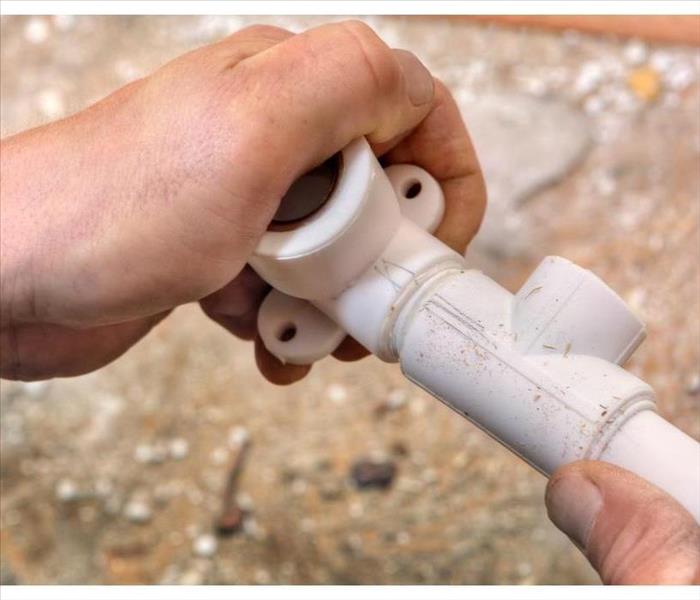 Checking if you have polybutylene pipes can better prepare you for upgrades that may be needed
Checking if you have polybutylene pipes can better prepare you for upgrades that may be needed
Leaking pipes can quickly lead to water damage in your Millville, OH, business. If left unchecked, it may require extensive cleanup by water damage and mold remediation restoration specialists. While any older pipe has the potential to eventually burst or leak, if your plumbing was installed between 1978 and 1995, there is a good chance they are polybutylene pipes, which generally only have a 10-to-15 year lifespan.
Determine Piping Type
During that time frame, this kind of piping became popular because it was cost-efficient, flexible, freeze-resistant, and easy to install. Over time, it became evident that the material wasn’t the best choice. The chemicals used in water treatment caused polybutylene pipes to get brittle, resulting in cracking and breaking. If your building still has them, they are long past due on being replaced. Unfortunately, repair is not an option for this type of plumbing. To determine if your pipes are made of this material, look for the letters PB on a pipe. Locations to check include:
- Around the water heater.
- In the basement entering through a wall.
- At the main shut-off valve or water meter.
- Behind sinks and toilets.
Time for Change
Although the thought of new plumbing may be overwhelming, the potential savings in water damage is worth the consideration. If a pipe bursts, it could lead to extensive downtime, which can be detrimental to a business. Contact a trusted plumbing professional to access the situation. If you are already dealing with leaks, it’s best to just modernize the system. A professional plumber will remove existing pipes and replace them with durable pipes and fittings that adhere to building codes. The replacement process usually takes two days, as well as another few days for the restoration of walls.
At the first signs of a leak, checking if you have polybutylene pipes can better prepare you for upgrades that may be needed. Although seemingly daunting, the long-term benefits are often worth the effort.
How To Know It Is Time To Change Your Supply Line
2/24/2020 (Permalink)
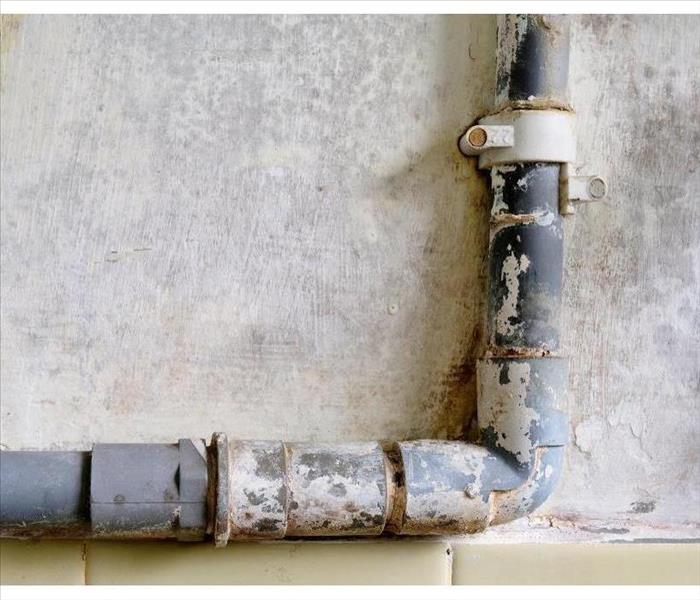 A supply line leak may mean you need to tighten its connection to a pipe
A supply line leak may mean you need to tighten its connection to a pipe
Three Signs To Decide It's Time To Change Your Supply Line
If you are noticing water issues in your home in Morgan Township, OH, they may be due to supply line damage. Checking your supply lines may not be at the top of your maintenance task list, but they can cause a lot of problems if they wear out. There are three signs you need to look for to decide if it's time to change your supply lines.
Visible Damage
You probably don't look behind your toilet very often. Failure to inspect your supply lines, however, can lead to a bathroom leak. During this inspection, it's important to look for visible signs of damage:
- Cracks
- Flaking
- Discoloration
If you see any of these things, you need to replace the supply line that carries water from the pipe to the toilet or appliance. Signs of supply line damage are the clearest indicator that it's time for a new one.
Frequent Leaks
Mystery leaks in your home can be a source of great frustration. According to water restoration experts, if you are seeing frequent leaks in the same area, it may be due to a faulty supply line. A supply line leak may mean you need to tighten its connection to the appliance or pipe. Otherwise, it may indicate that it's time to replace the line altogether.
Expired Warranty
There may be nothing wrong with your supply lines. If you have plastic lines, however, they do wear out eventually. While steel-braided lines should have a lifetime warranty, plastic lines need to be replaced every 5-8 years, depending on the specific manufacturer. If it has been a few years or if you don't know how old the supply lines are, it's a good idea to replace them with new ones. You may be able to stop leaks before they happen.
Supply line damage can lead to significant water loss in your home. With regular inspections and replacement of old lines, you can avoid leaks.
How to Reduce Business Interruption Costs Following a Disaster
1/30/2020 (Permalink)
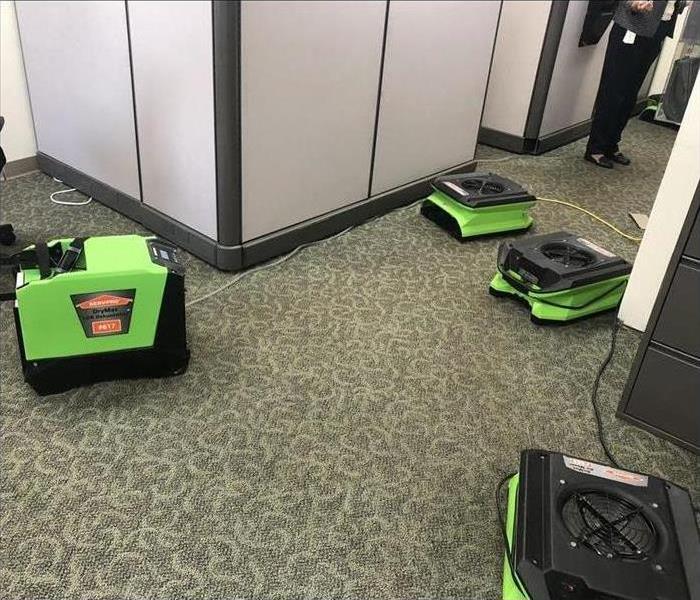 Water damage in Reilly, OH
Water damage in Reilly, OH
Whatever type of work you do, it's important to maintain a productive, efficient workplace. Keeping up with customer demand and providing the rights goods and services will help you stay ahead of the competition in Reilly, OH. A workplace emergency such as a fire, widespread mold growth or flooding can put your business at risk of shutting down for a time. You can't afford this, but there are ways to minimize the interruptions to your operations.
The Consequences of Workplace Disasters
Minor accidents can happen from time to time and not affect how your business functions. Something more serious such as flooding, however, can make it challenging to continue day-to-day work. Water problems or other worrisome issues can have the following effects:
- Damage equipment such as computers, servers and printers
- Ruin important documents
- Make the building unsuitable or unsafe for work
- Damage or destroy the structural integrity of the building
Act Quickly
The most important step to take after something such as large water damage in the office is to start the cleanup and restoration process immediately. As soon as you notice problems in your building, call your commercial property insurance agent and file a claim. Provide as many details as you can about the incident and the damage it has caused. You should then find an experienced disaster recovery company so these professionals can start getting your office back to working order.
How the Pros Will Reduce Your Business Interruption
The cleanup technicians may not be able to salvage everything in your office, but they can minimize the damage. This will translate into lower costs for you and a faster return to work. Whether water came into the facility from a broken pipe or sewer backup, crews will remove it, dry and sanitize the area, and replace or rebuild all materials.
Flooding can lead to devastating damage to your office. Fortunately, the more quickly you can get professional teams to your building, the less time you'll have to be in shutdown mode.
Supply Line Maintenance Tips
12/10/2019 (Permalink)
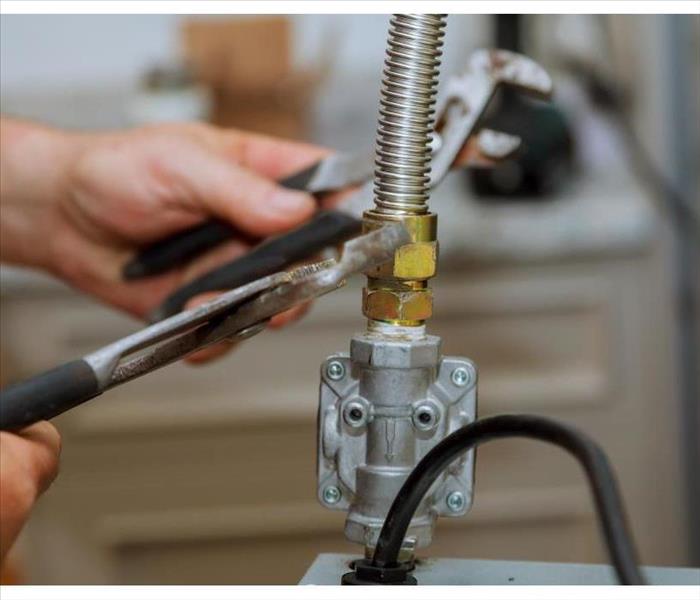 It's important to know the kind of supply line you have
It's important to know the kind of supply line you have
Supply Line Maintenance Tips
When you think of issues that could cause flooding in your home in Hanover Township, OH, supply line damage is probably not at the top of your list. More often than not, flooding is caused by a malfunctioning appliance or sewer backup. A broken supply line, however, can also cause a lot of water damage in a short amount of time. Making sure all your supply lines stay in good working order can help you avoid some leaks.
How To Spot Damage
Inspecting your supply lines on a regular basis can help you head a potential bathroom leak off at the pass. There are several issues to watch for:
- Loose bolts connecting line to wall or appliance
- Visible wear and tear on supply line
- Moisture on the floor near the water supply
If you notice any of these problems, you may need to fix the supply line damage or replace it altogether. Call water restoration specialists if you have an ongoing leak, because you may have water damage even if you can't see it.
When To Replace Lines
Even if you don't see any visible damage, you can still have a supply line leak if they get old and wear out. Supply lines are either made of plastic or steel, and it's important to know the kind of supply lines you have. A plastic supply line needs to be replaced every 5-6 years, even if you don't see any visible damage. A steel braided line, however, often comes with a lifetime warranty. If you upgrade to a new appliance, it's a good idea to replace the supply line as well to ensure proper fit and function.
Every part of your plumbing system must be kept in good working order to avoid potentially costly water damage repairs. Checking for supply line damage as part of your regular maintenance schedule and replacing old or damaged lines are good ways to prevent leaks.
First Check Your Bathtub and Shower for Leaks
10/16/2019 (Permalink)
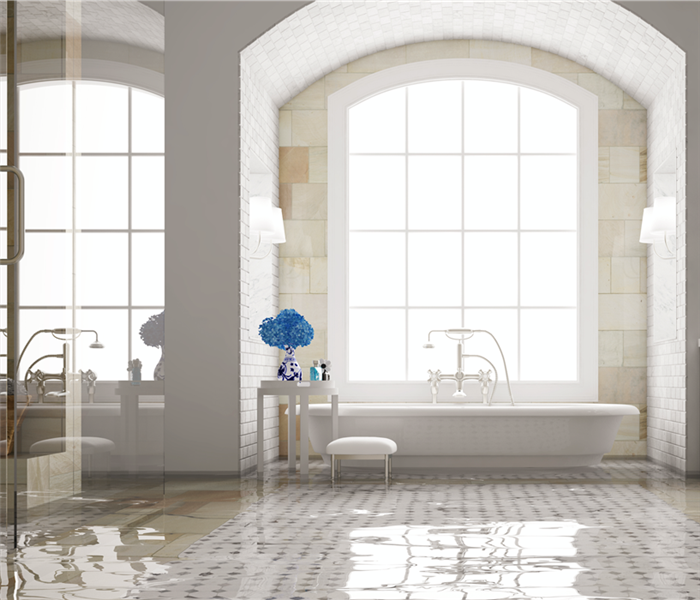 Water damage on bathroom due to leaking bathtub in Lemon Township, OH
Water damage on bathroom due to leaking bathtub in Lemon Township, OH
First Check Your Bathtub and Shower for Leaks
It’s discouraging to see a water-stained ceiling in your home. Realizing that there is a bathroom above that stain makes it worse. Fixing the problem is simple. Finding it is the challenge. Possible sources are a:
- Bathtub leak;
- Toilet leak;
- Supply line leak; or
- Drain leak.
Use the Process of Elimination to Find the Leak
Finding the source of the leak may eventually require tearing out walls or ceilings. Most homeowners prefer not to go that route until there is no other choice. Evaluating the tub and shower allows you to test for a leak without performing any demolition. The simplicity of this approach makes it an excellent first step. This procedure can help identify or exclude them as the sources of the problem.
- Give the ceiling a chance to dry. If possible, discontinue using the shower or tub. If the ceiling doesn’t dry, the problem is unlikely to be a shower or bathtub leak.
- Cover the drain with tape. Only block the holes to the drain. Leave the area where the drain meets the tub or shower open.
- Open the valves. Fill the tub with water to a depth of a couple of inches. Fill the shower base to a depth of an inch but not to the point of overflowing.
- Check the ceiling for added moisture. An increase in the amount of moisture would indicate a leaking shower or tub.
Determine the Cause of the Leak
For unbroken tubs and shower bases, the most likely place for a leak is the point where the metal drain meets the tub or shower. For a tile shower, the problem may be a shower pan leak. Old or poorly installed shower pans can be the source of trouble.
A shower or bathtub leak can cause substantial water damage in your home. It is crucial to remove the moisture and repair the damage before mold becomes a problem. Fortunately, there are local water damage remediation specialists located in the Lemon Township, OH, area. When they finish the cleanup, it will be “Like it never even happened.”
Replace Your Leaking Toilet in 5 Easy Steps
8/21/2019 (Permalink)
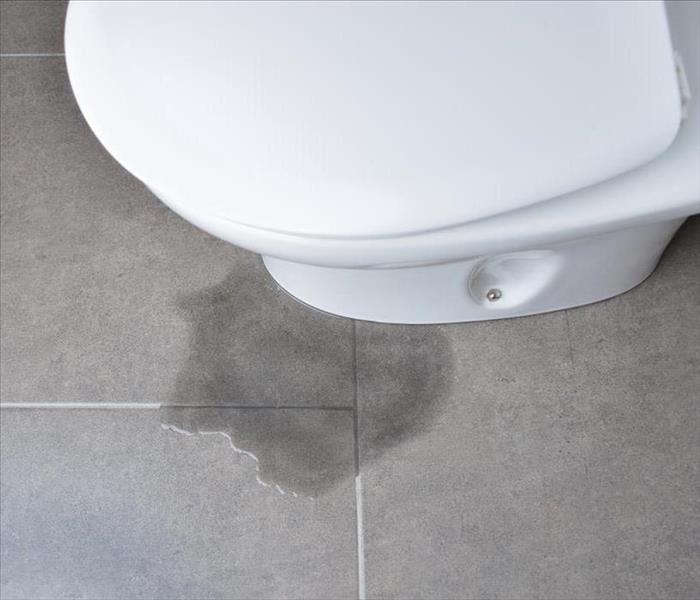 Leaking toilet in a Hanover Township, OH home
Leaking toilet in a Hanover Township, OH home
Have You Found Yourself With a Leaking Toilet?
It may be time to get it replaced. If you’d like to tackle replacing your toilet DIY-style, grab a buddy and read on for these five easy steps.
Prep the Area
The first thing you’ll want to do to is to disconnect the water supply. Once done, drain the water from your toilet. This can be done by flushing the toilet repeatedly and then removing the remaining water with a sponge. Disconnect the water supply line from the bottom of the toilet tank.
Detach Your Old Toilet
Loosen the bolts at the base of your toilet. Using a sharp knife, very carefully pry off the caulk seal around the base of the toilet bowl. You can sway the toilet back and forth to wrench the base from the seal. The toilet can now be removed.
Prepare for Installation
Use a knife to remove the wax ring located at the base of your toilet. You may now install a new wax ring. In some instances, simply replacing this wax ring can solve the issue of a leaking toilet.
Set Your New Toilet
Caulk the bottom of the new bowl and lift it into place, guiding it securely over the hole. Secure the base with bolts. Attach the tank to the bowl.
Check Your Toilet Repair Work
Make sure your toilet is level before reconnecting your water supply. Once the tank has filled with water, give it a couple of test flushes to check for leaks or blockages. Before you call it a day, you may want to check for any water damage, mold or mildew. If you are in need of further remediation, there’s no need to do it on your own, there are experts in Hanover Township, OH, that can help!
Replacing your old, leaking toilet is a manageable task when you’re equipped with the right tools and a proper guide. Rest easy with the knowledge that as a homeowner you can undertake any task with the help of friends and professionals.
How Do I Prevent Water Damage?
7/19/2019 (Permalink)
Experiencing a water loss can be an extremely traumatic experience for you and your family. That is why it is so important to be as prepared as possible. Here are a few things to think about, to be better prepared from a water loss.
Preparing for Water Damage
- Make sure that you are aware of where all of your shut off valves are located. These can be critical in minimizing damages if you have a pipe break in your home.
- Be sure to have all of your emergency contacts in your cell phone. This can include local city utilities, plumbers, electricians and any other service company. SERVPRO of West Hamilton/ Oxford is a 24/7 company so you are welcome to call us at anytime.
Although there are times where we can't prevent the worst in happening to our homes, the more we are prepared the better chance we have of minimizing the damages.
Winter Isn’t Over: Be On the Lookout for Frozen Pipes
4/18/2019 (Permalink)
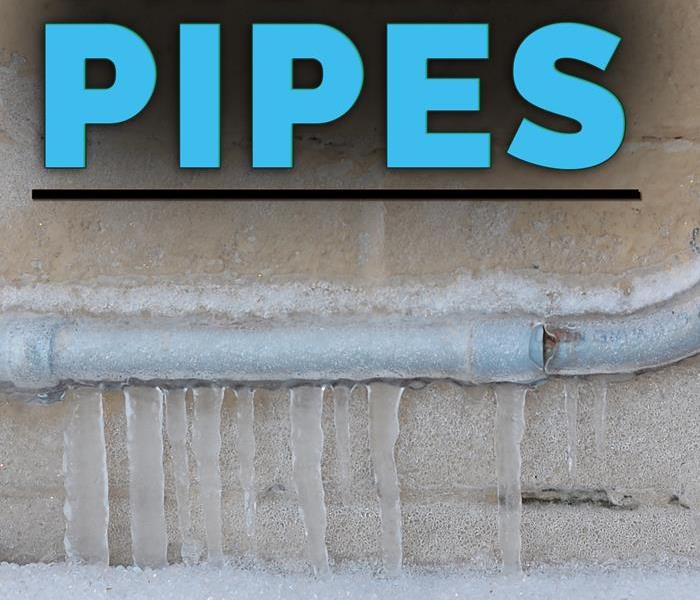 Keep an eye on your exposed lines and watch for frost.
Keep an eye on your exposed lines and watch for frost.
Cold weather is still present in the first few weeks of March. The temperature may go from 40-50 degrees during the day down to 20 degrees at night. Therefore, frozen pipes are still a concern for many businesses, especially those operating out of warehouse-type facilities, and it pays to be aware of the signs of freezing pipes so that you can be proactive rather than reactive to potential water damage.
1. Frost
The first sign of potential problems is the appearance of frost on your water pipes. Frosting may occur on pipes that are located on or near exterior walls. However, it is also possible that it happens on plumbing located in an inadequately heated facility. If pipes are allowed to persist this way, then the pressure of freezing water will likely result in broken pipes and flooding.
2. Odor
Odor is another sign of freezing water lines. As water freezes, it does not allow for proper ventilation which can lead to gases and odd odors coming back up through floor drains and sinks. These smells are a significant sign of pending water damage and disaster.
3. Lack of Water Pressure or No Water
The last sign of frozen lines is the reduction or complete loss of water pressure. If you notice that the faucets in your facility have limited to no flow, then you should call a plumbing specialist in the Hamilton, OH area before a thorough water cleanup is necessary. No water means that there is a blockage, and if your facility has experienced frozen lines in the past, then you are likely dealing with a complete freeze, which can lead to burst pipes and flooding.
Water damage caused by freezing results in more than flooding; it causes damage to the plumbing itself. Unlike a backup where water overflows, freezing creates breaks, cracks and splits, meaning that repairs are extensive and costly.
Don’t let the spring thaw calm your nerves about the winter cold. Keep an eye on your exposed lines and watch for frost. Pay attention to strange odors and call for help if you have a sudden loss of water pressure.
How to Prepare For a Visit From Your Home Adjuster
3/18/2019 (Permalink)
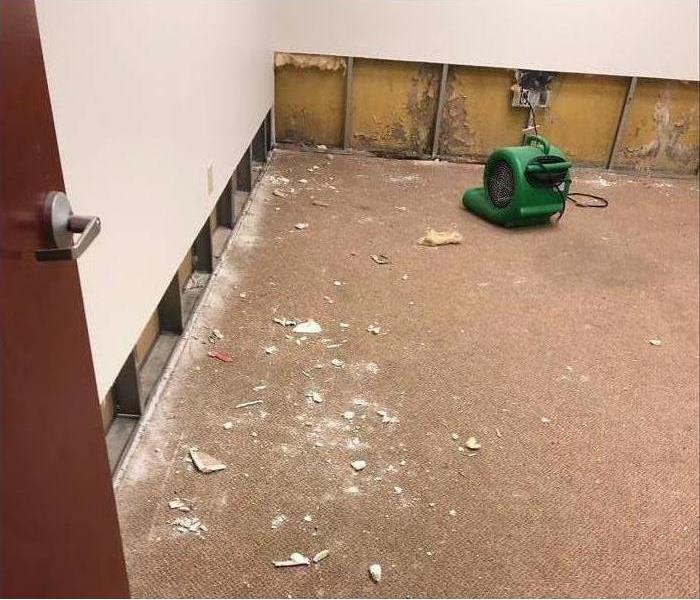 In the event of damage to your home, it is best to contact your insurance company as soon as possible.
In the event of damage to your home, it is best to contact your insurance company as soon as possible.
How To Prepare For A Visit From Your Home Adjuster
In the event of damage to your Oxford, OH home, it is best to contact your insurance company as soon as possible. This helps the process go more quickly and will get you living comfortably in your home again sooner. Before the claim can be approved, you will need to meet with a home adjuster who will help assess the damages. Here are a few things that you can do to prepare for the visit.
1. Keep Track of Damaged Areas that Need to Be Shown to the Adjuster
Before the adjuster arrives, you should examine your home and locate any areas with damage related to the claim. Depending on the cause of the damage, this can include broken or missing roof tiles, cracked or warped walls or flooring or flooded areas. This information can help determine how much it will cost for a damage remediation specialist to make repairs.
2. Make a List of Damaged Belongings
It is likely that the structure of your home is not the only thing that was affected. If there has also been damage to your personal belongings, then you should keep track of that as well. You should create a list of items that have been destroyed or damaged that you will provide to the adjuster. Taking pictures can be helpful as well. Be sure not to throw out any of the damaged items before meeting with the home adjuster.
3. Fill Out Any Necessary Paperwork
When you file an insurance claim, there will likely be quite a bit of paperwork that you need to fill out. You should complete this as soon as possible to get the process finished more quickly. If you have any questions, the adjuster can help.
Because meeting with a home adjuster is an important step in filing a claim, you should make sure that you are prepared. If the visit goes smoothly, it will make the whole process go more easily.
Potential Effects of Water Leaks on Building Materials
1/15/2019 (Permalink)
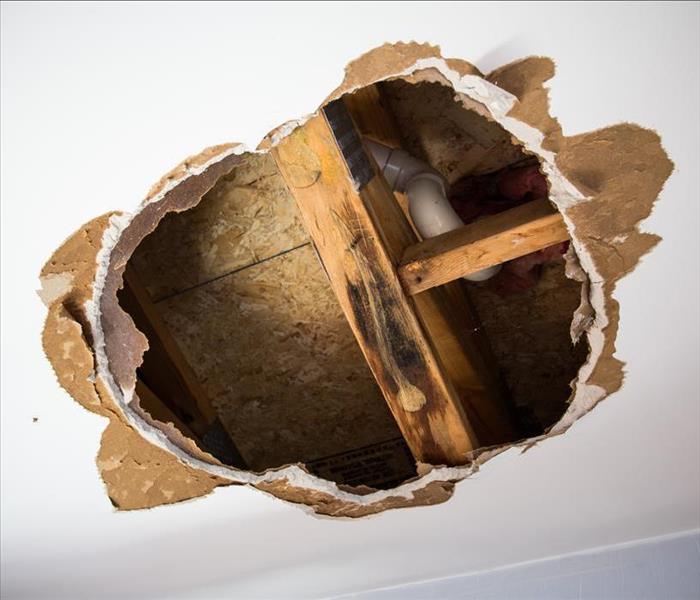 Ceiling damage due to a broken pipe in a Ross, OH home
Ceiling damage due to a broken pipe in a Ross, OH home
A broken pipe in your home in Ross, OH, can cause significant water damage. This is particularly true if you don’t notice the problem when it first occurs or you don’t call for repairs right away. Signs of damage can include swelling wood, water stains and even mold. The longer the excess water is in contact with your house’s walls, support beams, flooring and ceiling materials, the more damage you are likely to see.
Choose Timeliness
If a supply line breaks, a lot of water will probably spill out and start pooling. It doesn’t take long for problems to manifest:
- The first few minutes - water can spread or cause rugs or other textiles to stain floors and walls
- The first few hours - wood frames and drywall start to absorb water and swell
- The first few days - clean water becomes gray water and may start to foster mold growth
As you can see, if you don’t get the problem resolved quickly, swelling wood is only one of the potential effects with which you may have to contend. The sooner water restoration specialists can assess and address the problem, the fewer problems you may end up having.
Minimize Risk
If the walls of your home are merely wet, avoiding additional damage may be as simple as drying them off. If your building materials have taken on water and started to expand, however, technicians must tear out the affected walls and beams and replace them with new, unblemished material. To minimize the risk of this happening, turn off the source of the water and hire someone to perform water pipe repair as soon as possible. Then you can focus on removing water and restoring your structure.
It doesn’t take long for a pipe or supply line break to result in swelling wood beams or saturated drywall. By addressing the leak quickly, you may be able to save your home from further damage.
Broken Pipes: What Will Your Insurer Cover?
12/30/2018 (Permalink)
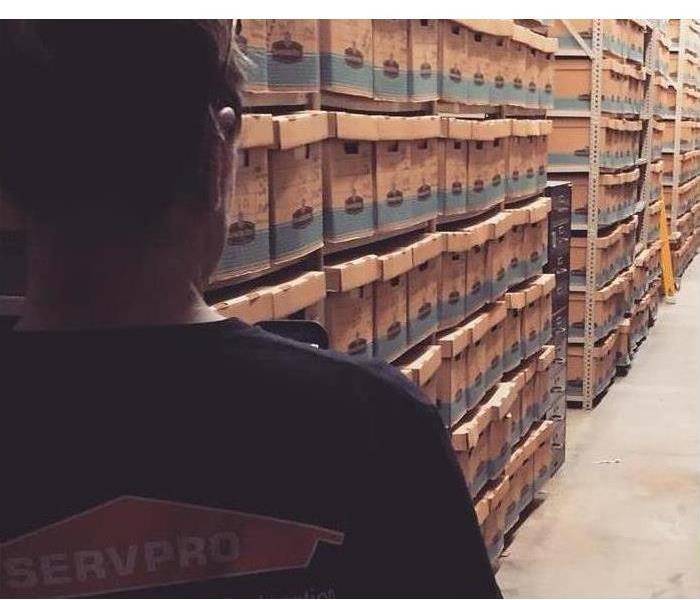 Restoring documents due to water loss in Hamilton, OH
Restoring documents due to water loss in Hamilton, OH
While every insurance coverage policy varies and is conditional, a sudden flood caused by broken pipes will likely be covered. However, that is dependent on the underlying circumstances and conditions that resulted in the pipe failure. In signing the insurance contract, homeowners make a promise to maintain their property, which means that whether you are covered depends on your commitment to that promise.
Sudden and Unexpected Breaks
Most insurers will cover sudden and unexpected breaks, meaning that there was no way to predict the mishap. However, many insurance companies have certain expectations for upkeep. Therefore, it is a good idea that you keep all receipts from inspections and repairs to prove that negligence was not a part of the pipe failure.
Secondary Damage
For flood claims that pass muster, an insurer will likely cover secondary damage as well. Secondary damage refers to any items that were harmed because of the water buildup or broken pipe — for instance, carpets, furnishings, artwork, important documents and any other material or equipment that may have been harmed.
Possible Prevention and Restoration
In addition to covering damage, many insurers will provide funds to fix a broken pipe, restore the damage, and even upgrade elements to prevent a potential disaster in the future. As these are significant expenses, your insurance provider may require you to get several quotes and estimates from emergency restoration companies in the Hamilton, OH, area. These companies are typically one-stop shops for all of your restoration needs, either handling your case entirely in-house or helping to facilitate contracts for renovation efforts.
A flood caused by broken pipes and leading to water damage is a significant problem for homeowners, but homeowner’s policy agreements usually protect them in these instances. As long as the homeowner can disprove negligence, if not already apparent, then an insurer will likely have no issue approving coverage on your insurance claim.
Will water damage hardwood floors?
5/4/2018 (Permalink)
If you live in a home with hardwood floors, and have a water loss in your home, you could be looking at severe damage.
Every situation is uniquely different. In some cases if it is detected quickly and there is access to the subfloor through a crawl space, the floors can be dried in place.
However if the floors begin to buckle and pop out, it could be too late to restore in place. In that case the damaged wood, would have to be removed and the subfloor and surrounding area would need to be dried. Once the drying is complete, the floors can be replaced and the floors can be refinished to match.
SERVPRO is able to help from start to finish. If you have any questions, feel free to reach out to us at anytime.




 24/7 Emergency Service
24/7 Emergency Service























